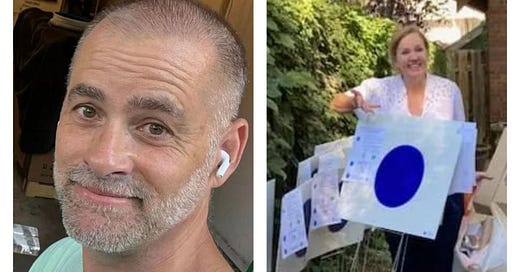Inside the media maelstrom: Lessons learned on the campaign trail from the founders of the Blue Dot movement
What a few months at ground zero taught a Nebraska couple.
As a news consumer, I usually come to a story as a blank slate: Maybe a little background knowledge, but rarely firsthand experience. But this campaign season, the tables turned as good family friends in Nebraska built a grass-roots movement into taking advantage of the state’s rules for allocating into electoral votes by congressional districts and ensuring that Omaha and the Second Congressional District was a “blue dot” in normally dyed-red Nebraska. Potentially a electoral vote tiebreaking blue dot.
And in knowing the people out front in the news stories, it offered some perspective on how the news gets put together, even for someone who works in news full time. Stepping outside of the work environment and into the reader role allowed some of that perspective to float back to me professionally.
The light bulb fully came on the first week of October, with a Barron’s article that quoted Jason Brown with a “Dang right.” Jason is a childhood friend of my wife’s and through college in Lincoln, where he met his wife, Ruth Huebner-Brown, while working and going to school. “Jason and Ruth sound so folksy!” was the text message I sent to my wife, Dana, expressing some skepticism at the writer’s opening.
So if I had these thoughts, what do the subjects of the stories feel about them? I asked Jason and Ruth to talk by phone, and just before Thanksgiving, we managed to talk for an hour, even as they were wrestling with the effects of the election. Back in the era of ombudsmen and reader’s representatives, the media rarely did something so focused on the subject. (I’ll raise the caveat of perhaps not complete professional detachment, since I count Jason and Ruth as friends for the past 30 or so years.) I don’t feel like I approached them any differently than someone I just met, but you’ll have to be the judge of that. Plus, that connection and knowledge were the genesis of the story, so … But I will step away from journalism convention and call them Jason and Ruth, if only because it’s shorter than Brown and Huebner-Brown.
Jason and Ruth never seemed to have had that skeptical moment that I did of the coverage. But they counted themselves pretty savvy media consumers (Jason was a student at the University of Nebraska-Lincoln College of Journalism and Mass Communications) and still were surprised how big everything got between Aug. 19 and Nov. 5.
Ruth had some key lessons learned with each interview. Among them:
Know yourself and know your limits. “You don’t have to say yes to every person who wants an interview,” she said.
You don’t have to have a prepared answer. In those first interviews, it felt like being on live TV, she said. “Do ask for a do-over,” especially if you need to be more comfortable.
One of things they definitely would have done differently was running everything from their home in Omaha. If they knew requests were going to come in from around the world, they would have found a storefront to handle the media influx along with the blue dot sign requests. “We had our home address out there from the beginning,” Ruth said.
For a time, reporters were having trouble tracking them down, as they weren’t posting their real names on Facebook. Ruth doesn’t use her legal first and middle name, so she couldn’t be found via voting records. “We did try to make it easier,” she added.
As the influx of interview requests grew came concerns about vetting the volume. They were waiting to be lampooned by Comedy Central but also concerned about becoming the subject of a partisan outfit like Project Veritas.
By Election Day, they felt like they “hardly had time to breathe,” with all the attention, Jason said. “But we owed the movement everything.”
In the back and forth of the campaign, those feelings would often surface. They felt very lucky to be able to put work on hold when they needed to recover. And the recovery continues in December, even as the movement expands. Jason’s taking a step back, even from the news, as the holidays approach. But the Blue Dot movement has expanded into other states, ones without the unusual electoral vote allocation: Iowa, Ohio, Askansas, Oklahoma and Minnesota, among them.
One final lesson was their resolve to keep their group independent from the Democratic campaign as Election Day approached. They felt in touch with the grass roots, which “made us proud and happy,” Ruth said. And that’s part of the next phase, which they termed as “circling the wagons” and “a grass-roots effort to reach out to people.”





About Nebraska’s blue dot, the state’s system for allocating electoral votes is up for debate: https://nebraskaexaminer.com/2025/01/30/defenders-of-nebraskas-blue-dot-come-out-in-force-against-winner-take-all-at-hearing/